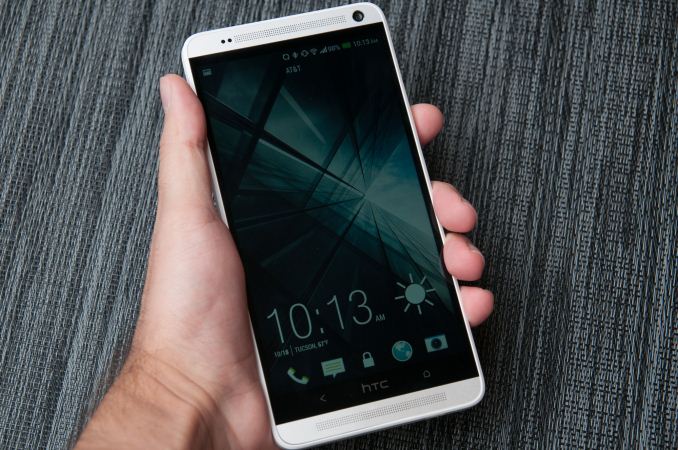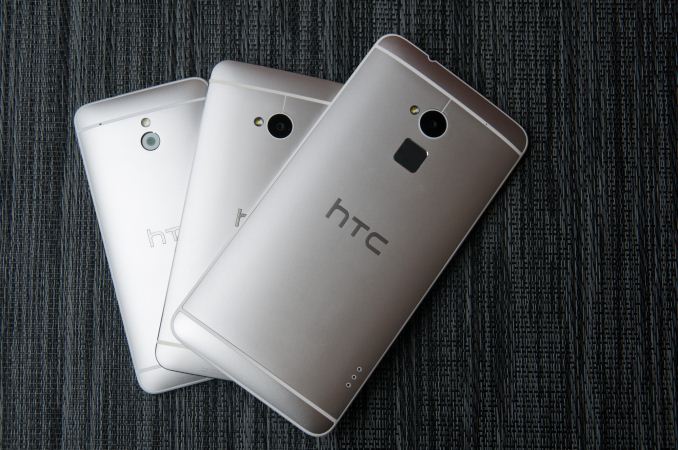HTC One max Review - It's Huge
by Brian Klug on October 28, 2013 10:00 AM EST- Posted in
- Smartphones
- HTC
- Mobile
- One
- Snapdragon 600
- Android 4.3
- One max
Concluding the One max review is difficult. I have a lot of conflicting thoughts about the larger sized smartphones and the state of that market, which seems to serve two purposes independently. For users who either don’t want or can’t budget for a tablet, the larger sized phones seem to bridge a functional gap between smartphone and tablet. Simultaneously, there are users who want the larger screen just to have it, and maybe there’s the perception that the larger phones still have some elevated status that comes with it. There’s a regional bias at play here too, and the One max seems to be a product designed to cater maybe more to some regions where supersized smartphones make up a bigger part of the market than others.
For me, the One max is probably a new upper bound in terms of size. It’s a very large phone, and although it fits in the front pockets of my jeans and shorts, it’s sometimes a stretch to sit down comfortably with the One max in a pocket. In terms of ergonomics, the One max is very much a dual-hand device.
The One max is really a product designed to fill out a hole in HTC’s One series portfolio than anything else, and doesn’t really change up the formula too much. It’s literally a scaled up version of the HTC One with few changes – OIS is unfortunately gone, the screen is obviously huge, there’s now a microSD card slot, and of course the new fingerprint sensor. Other than that though, the One max really is the One scaled up to gigantic size, with parts of the One mini tossed in for good measure.
I’ve said my part on the fingerprint sensor on the One max already. It works but isn’t the best or most intuitive implementation to date, although I think it’s fairly easy to make the case that nobody, not even Apple, has nailed a fingerprint sensor yet. The fingerprint scanner’s location on the back makes sense when you’re holding the One max in one hand, but becomes a problem when you’re using the phone on a flat surface. The use of a swipe sensor as well makes positioning on the back somewhat problematic unless you enroll fingers at a natural angle.
There’s also that elephant in the room about platform, specifically HTC’s inclusion of Snapdragon 600 APQ8064T instead of the faster Snapdragon 800 MSM8974 we’re seeing devices start shipping with right now. Although 8064 is still plenty fast and no slouch, there’s still a perceptible performance delta between an 8064 device and the newer 8974 phones I have on my desk now. I worry a lot about whether HTC will fall behind on platform, especially since it used to be the one OEM always shipping new Qualcomm silicon first. I have a feeling the One max saw platform change at the last minute, delaying its launch, but that's almost entirely speculation.
If you want a larger-screened smartphone and liked the One but have been waiting for a long time for the One max, by all means, get it. If you want a larger screened smartphone however, I think it’s easy to make the case that there are better devices out there right now. Had the One max arrived a month or two after the launch of the original One, this conclusion would've likely been a very different one.













197 Comments
View All Comments
smartypnt4 - Monday, October 28, 2013 - link
One thing people always brag about on Android is consumer choice. If Samsung more fits your needs, more power to you. But I fail to see how removing one of the top tier Android phone manufacturers is a good thing. I don't want any one company to be massively ahead of the rest in market share, because I believe some competition is a good thing and prevents companies from resting on their previous success and putting out crap new products.Say what you will about mircoSD slots. Personally, I don't store much on my phone anyway, so it's not a big deal to me. But please don't espouse the absurd opinion that removing players from the Android space will in any way improve it.
smartypnt4 - Monday, October 28, 2013 - link
Shit. On my phone. Did not mean to reply to you, but rather the guy you commented on. My bad.JeffFlanagan - Monday, October 28, 2013 - link
>Shit. On my phone.OK, but you're going to need a new phone.
nerd1 - Monday, October 28, 2013 - link
HTC one is a nice device but it has too many deal breakers for me and more (no micro sd, sealed battery, almost non-repairable, terrible QC, low-resolution camera)They basically shot their own feet, trying the apple way, while being no apple.
smartypnt4 - Monday, October 28, 2013 - link
Clearly you missed my point. I'm not interested in arguing the merits of a removable battery or microSD card slot. All I'm saying is that dude needs to chill out. If the Android space is truly about choice, what do you care what HTC does as long as SOMEONE makes the phone you want. In this case, HTC's phones this year clearly don't meet your needs/requirements, and that's fine. Saying they shot themselves in the foot is a bit harsh, though. I know several people who bought HTC Ones over SGS4's simply because of how the thing felt when they held the device. Say what you will about specs, features, etc., but not everyone values the same things you do. Hard to accept, I know. But my good lord. Are you really so shortsighted as to believe that the general population gives a rat's ass about removable batteries, SD card slots, phone repairability (wtf?), anecdotal evidence of bad QC, and a camera that makes heavy tradeoffs (in this case, IQ for low-light performance)?Not everyone has exactly the same desires or needs as you. Which is the beauty of the Android space: people have the luxury of choice, which you only get with multiple manufacturers competing in the same space.
/endrant
nerd1 - Monday, October 28, 2013 - link
So the device w/o micro sd slot is effectively $100-200 more expensive than device with one.iPhone 5s 64GB: $399 w/contract, total storage 64GB
S4 16GB + 64GB sdxc : around $200 w/contract, total storage 80GB
I know companies prefer to removing the slot to sell the high capacity devices with greater margin (BOM difference of 16GB and 64GB devices is almost negligible) but why we consumers blindly follow what they are doing?
MKy - Monday, October 28, 2013 - link
I can understand Apple there. Adding an SD card slot would be adding a means for the user to completely ruin the experience. Internal flash of my Ipad 4 reads/writes about 160MB/s, don't know about the newer models. A cheap SD card reads about 4 MB/s, writes even worse. So imagine running apps off it or using it as data storage. Would be painful.Spunjji - Monday, October 28, 2013 - link
Simple solution: Refuse to support cheap-ass storage. Validate some cards and support those, refuse app installation to SD. My 64GB Micro SDXC benches faster than most phone NAND... it cost me £40.kyuu - Monday, October 28, 2013 - link
I haven't been able to find any actual data on the storage performance of the iPad 4 (or any iPad for that matter), but I find your 160MB/s number rather unlikely. The storage used in iPads is the same used in iPhones, to the best of my knowledge, which isn't very fast.MKy - Monday, October 28, 2013 - link
Actually it is that fast. You can find benchmarking tools in the app store and even measure it by hand - open a say 5 gig video in one app and then choose open in another, then count the seconds it takes to copy it over (the delay after issuing the command) and calculate. The flash in iphone 5 is about the same speed.